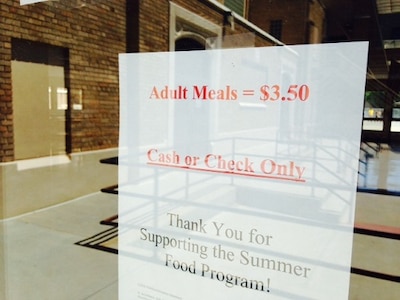The summer meal program in the cafeteria at Estes Park Elementary School is a little different than most. Here, in the shadow of Rocky Mountain National Park, it’s not just kids who eat for free, as is the case at most other sites across Colorado and the nation. Parents are invited to dig in as well.
It’s been that way since 2011 when an ad hoc group of retired teachers called the “Kids Café Committee” decided to raise some extra funds for that purpose, knowing the town’s tourist industry relied on low-wage service workers who routinely struggle to make ends meet.
“Hungry parents are just as important as hungry kids,” said MaryAnn Martin, one of four current committee members. “You can’t feed these kids and let those adults not eat, knowing in all likelihood, they’re going home and not eating till dinner.”
While thousands of Colorado children 18 and under have access to free breakfast and lunch during the summer through nutrition programs funded by the United States Department of Agriculture, parents do not. In fact, USDA rules prohibit parents from eating off children’s plates, and many sites prominently display signs to this effect. At some locations, parents can purchase their own meals for around $3, but parents still sometimes sit idle watching their children eat.
Beyond the broader questions of how to meet the needs of hungry parents and caregivers, some advocates worry that depriving adults of free summer meals may dissuade them from bringing their kids. Of particular concern are toddlers and preschoolers, who can’t get to summer food sites without an adult.
Boosting summer meal participation has been a key priority of USDA officials in recent years, particularly after declining participation during the recession. While rates went up slightly last year, they still lag well below school-year participation.
According to a report published this month by the national Food Research and Action Center, federally-funded summer nutrition programs — there are two versions — served 15.1 children for every 100 low-income children who participated in the school lunch program in 2012-13.
Still, there’s not strong evidence either way that free parent meals will help close that gap. In addition, some anti-hunger leaders caution that offering free parent meals may not be right for every site. For example, some sites weave summer meals into several hours of supervised activity designed for kids to attend without parents.
“I don’t think it’s a one size fits all answer across the board,” said Kathy Underhill, executive director of Hunger Free Colorado. “For me, it’s about each site or sponsor knowing their community and knowing what their community’s needs are.”
Divining the impact on attendance
Perhaps the biggest barrier to determining whether free parent meals affect participation by children is that there’s no mechanism for tracking which sponsors offer the benefit from summer to summer or how it affects participation at those sites. A USDA representative noted that some sites in both Colorado and Virginia have offered free adults meals in the past, but said the agency doesn’t collect data on the topic.
In Colorado, there have been efforts in two recent years to provide free adult meals at multiple summer meal sites. The first and largest, came in 2011 after an anonymous donor gave money to Hunger Free Colorado, which also contributed funds for the project. All told, nearly $63,000 worth of adult meals were provided at 92 meal sites across Colorado, including those run by the Denver, Thompson, Adams 50, Alamosa and Trinidad school districts.
The donor had volunteered at summer meal sites and witnessed the plight of some parents, said Underhill.
“She saw first-hand it’s really hard when parents come or caregivers come … when they have to sit there and not eat. It doesn’t feel good.”
Tammy Rempe, Thompson’s director of nutrition services, said she believes child participation increased that year because more parents started coming, bringing their kids with them.
“I think the need in Loveland is much greater than anyone imagines,” she said. “Maybe we have a hidden poverty or a low-middle class income group whose needs are continuing to grow.”
While Hunger Free didn’t attempt to gauge participation changes after the 2011 donation , the organization did collect data the next year when it paid for adult meals at 11 sites from mid-July to mid-August to see if that would help drive late-summer meal participation. Underhill said it didn’t generally change participation rates among children, but it did create a stronger sense of community and drew appreciation from site organizers and participating parents.

There may be no definitive evidence showing that free parent meals push up participation by children, but the lack of free adult meals proved lethal for one meal program in Manitou Springs.
Laurie Wood, director of the school district’s Partners for Healthy Choices program, helped launch the inaugural summer lunch program at a local church last year. While the program wasn’t funded with USDA dollars, the grant money that paid for it had similar parameters.
At first, families showed up—most from a corridor filled with motels, hotels and mobile home parks. Although fliers advertising the lunch program stated that the meals were just for children, Wood said parents were surprised to learn they couldn’t eat too.
“They thought if they showed up they would get fed.”
When that didn’t happen, some tried eating off their children’s plates. But as the rules were enforced, participation dwindled and the program had to be cancelled mid-way through.
“The adults just abandoned ship with the kids,” said Wood. “It went from 15 to 10 to eight to three.”
Wood said she hopes to fund-raise over the next year so she and other community partners can take another stab at providing summer meals – this time with their own set of rules that allow both adults and kids to eat for free.
Building community
Agape Christian Church in Denver’s Five Points neighborhood is another Colorado summer meal site that provides for guests of all ages. Adults meals, whether for parents, grandparents or neighbors accompanying children, cost just 25 cents.
“I just charge them a quarter so there’s some dignity behind it,” said Eddie Mae Woolfolk, coordinator of the program since it began seven years ago. “A person feels better about themselves if they give something.”
The church, which serves 20-45 children and six to seven adults a day, covers the additional cost of the adult meals through donations. It costs about $1,000 a summer.
Aside from feeding the hungry, proponents of adult-inclusive models say it’s important for adults to be at the table for social reasons. Woolfolk said for some families that attend her lunch program it may be the only meal that parents and children eat together.
In Estes Park, which Martin said doesn’t have the sidewalks and cozy neighborhoods of a traditional residential area, attracting parents to the summer meal program allows them to meet others in the community.
“Food … is such a powerful and great way to bring people together,” said Wood.
The money crunch
While there are valid arguments that free adult meals don’t make sense in all communities and are not part of the core mission of the USDA’s summer meal programs, money too is an inevitable sticking point. With meals costing $2 to $3.50 per person, the expense can gobble up funds quickly.

Those involved in the 2011 parent meal effort spearheaded by the anonymous donor agree on that point.
“The need was so great that that money was spent very rapidly,” said Rempe.
“I was so floored by the demand,” said Underhill. “I’ve been doing anti-hunger work for a couple decades and I don’t get surprised a lot. … I got really surprised by the demand for adult meals.”
While Rempe said it “would be awesome” to offer free parent meals again in the Thompson district, she said it’s not possible with today’s funding sources.
Theresa Hafner, executive director of Enterprise Management for Denver Public Schools, contemplated a smaller-scale program — say free parent meals once a week. Even that, she speculated, would help boost summer meal participation among children and get parents comfortable with the school food served during the school year.
Bruce Wallace, project director of the Food Bank of Larimer County, which sponsors the Kid’s Café program in Estes Park, believes the committee’s efforts to include parents represents ground-breaking work. At the same time, he said, “If it gets too big my concern would be, gosh, we can’t afford this.”
For the Kid’s Café Committee members, who Wallace calls “your classic local community heroes,” spending $1,000 to provide 10 adult meals a day for two months seems manageable.
“When you think about how many adults actually show up – It’s a car full of kids and maybe one or two adults. So you’re not out that much,” said Martin. “We just said, ‘Feed them, how expensive could it possibly be?’”

